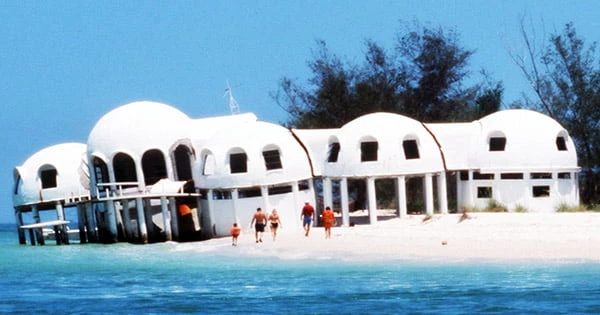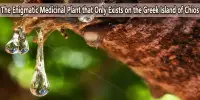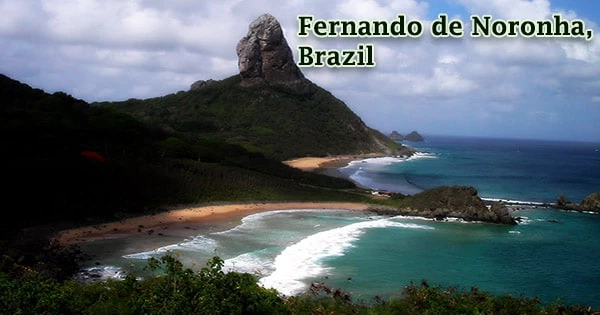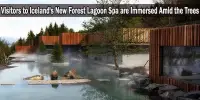The Cape Romano Dome House is an abandoned house in the Ten Thousand Islands in Collier County, Florida, consisting of six dome-shaped modules on stilts. It is located roughly 300 feet offshore from Cape Romano Island (as of 2019), south of Marco Island. The Dome House is a concrete igloo-like edifice made up of white dome chambers that is slowly eroding and sinking into the ocean. It was built by retired businessman Bob Lee in 1979, abandoned in 1992, and sold to John Tosto in 2005. There are no landings or docking facilities on the structure, which was never designed to be accessed by water.
For many years, the strange structures on Marco Island’s secluded southern extremity at Cape Romano, Florida, remained a mystery. Some locals and abandoned explorers speculated that it may have been the community house of a hidden sect, while others said they had been abandoned by extraterrestrials. While the “Morgan Island Dome Home” was erected on Morgan Island, erosion had filled up the little natural channel (Morgan Pass) between Morgan and Cape Romano, separating Morgan Island from the rest of the island.
Many people are aware of its location, but its origins have sparked controversy, with theories ranging from aliens to hidden cults. It was, in fact, constructed by a retired oil producer and inventor. In addition, persistent erosion of the barrier islands in this location has resulted in the property sitting out in the ocean, with Cape Romano being the closest island. The sea is claiming the domes now, creeping inches closer to their watery demise each day, yet the enigma of the space age constructions has been solved.
With 1978 and 1979, Bob Lee, a now-deceased retired oil producer, spent most of his time surveying and acquiring land on Morgan Island in the aim of building a holiday house. In 1980, he began construction on the house with the intention of making it totally self-sufficient and environmentally friendly. He began by transporting the essential supplies to the island on a boat, including metal dome forms, two concrete mixers, and freshwater to mix the cement.

The buildings were constructed in 1981, and Lee’s original vision for the unconventional holiday house was for it to be a self-sufficient, environmentally friendly retreat for his family. The elevated apartments themselves, which would be heated by igniting fires amid the concrete pylons underneath the rooms, and the dome-shaped roofs, which would guide rainwater into troughs that would later be collected for bathing and dishwater, are among the novelties at the site.
The dwellings of the Cape Romano are no more extraterrestrial than the alien-looking fish that swim around them in the waters today. The home was constructed up of six sturdy, linked dome structures, some of which had two floors, that made up the house’s rooms. It had three bedrooms and three baths and was 2,400 square feet. Because of Florida’s volatile weather, the robust, circular domes were able to withstand hurricane gusts, and Hurricane Andrew only caused little damage years later.
Rainwater would hit the domes and wash down into a gutter system that encircled them, eventually leading to a cistern beneath the main dome. The water was then able to be utilized for activities like showers and dishwashing after passing through filters. Solar panels were added, supplying the property with free power. Bob Lee developed a full-scale model of the Cape Romano building on land he owned in Gatlinburg, Tennessee, before erecting it. The dome house in Tennessee is still standing. Lee was known for working on his own projects, and he intended the house to be self-sufficient and operate on solar power.
Lee and his family sold the Cape Romano Dome House in 1984, barely two years after it was completed in 1982. When the owner ran into financial difficulties, the residence was repossessed in 1987, and the family remained there until 1993. The island was already shifting at the time, and other residences in the region had been swept away. The robust, circular domes were able to withstand hurricane winds with little damage, even in the stormy Florida weather.
Unfortunately, when the environment on the island’s border changed, simple erosion rendered the dwellings uninhabitable. Bob Lee, his wife Margaret, and their children, including a daughter named Jane, built the house as a holiday home. Coastal Breeze News spoke with Jane Maples, née Lee, about the local attention and controversy the home drew in its early years. The sea began to overcome the hard beach on which the domes were erected, and the domes were encircled on all sides by water. They only have a chance of surviving because of the concrete pillars that keep them above the flood line.
John Tosto boldly acquired the home in 2005, shortly before Hurricane Wilma, which unfortunately did significant damage to the domes and washed away section of the shoreline. Tosto intended to move the domes off of state-owned land and into line with county building rules. The domes will be lifted by crane and placed on new concrete or steel pilings more than 50 feet from the high tide line and at least 25 feet from the site’s wetlands.
The permission application states that construction supplies would be brought by barge, and work will be scheduled to avoid sea turtle and shorebird breeding seasons. The Tostos never really dismantled the houses for unclear reasons, which no certainly resulted in a few heavy penalties from the government, but also left a rather intriguing location for residents and abandoned aficionados to explore. Despite the fact that Tosto had produced an engineer’s certificate confirming that the home was repairable at the time, the board voted against him, citing his lack of proactive actions to protect the house in the past.
The structures are still there today, but owing to shifting shorelines, they are so far from the beach that any attempt to save them has most likely been futile. Bob’s ideal house will undoubtedly soon be providing a fantastic artificial reef for some fish. Two of the westernmost domes collapsed into the water after Hurricane Irma slammed the area in September 2017 as a Category 3 hurricane, leaving four standing.
















